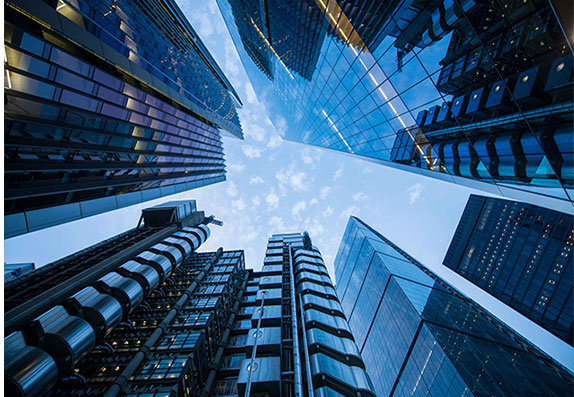
Explore effective intercom access control solutions to strengthen the security of your commercial property, effectively ensuring a safe environment for employees and visitors alike.
The infrastructure of commercial buildings is complex as the physical make-up of these spaces is usually divided into commercial facilities (commonly retail stores) on lower floors, while office spaces comprise upper floors. Maintaining security is equally challenging due to the diverse range of individuals using these spaces, including employees, vendors, and guests. Every user should have a seamless experience fulfilling their respective purpose within their authorized areas, which naturally requires a security system and access controls.
Given the complexity of securing commercial buildings that accommodate both offices and retail vendors, it is essential to consider that the plan deployed is multi-faceted and flexible enough to cater to varying users' needs.
A combination of solutions that work in tandem must be implemented to create an effective security plan for commercial buildings. These security measures range from networked solutions, like an IP (internet protocol) video intercom system, to other closely related platforms like mobile applications.
Controlling access in commercial buildings can be broken down into three key elements: an identification/access card, a personal identification number (PIN), and a biometrics or database reference. These elements are implemented throughout various entry points at commercial buildings, including parking garage gates, office doors, and card readers or keypads.
In enabling access in commercial buildings, mobile credentialing is quickly trending. As opposed to traditional methods like security badges, facilities now utilize smartphones, tablets, security codes, and mobile applications to facilitate secure entry. Commercial buildings also use biometric information to easily authenticate visitors' credentials via fingerprints, iris scans, and facial recognition. Like security badges, these systems can be customized with access restrictions to a specific time, date, and area. Additional advantages include cost savings in badge production and convenience as users can be enrolled through a simple process.
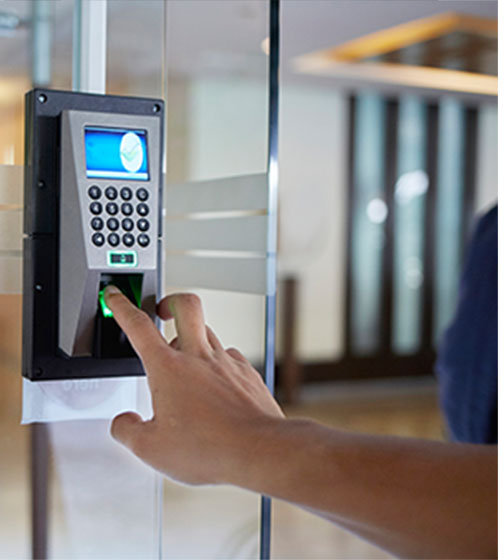
These solutions are valuable in commercial buildings with office spaces and retail stores, where respective access is needed. An access control system can be designed to authorize entry to office workers and employees only to their workspaces while also limiting commercial users like retail vendors and shoppers from accessing these restricted areas.

Previously, commercial buildings relied on manual sign-ins and physical logs to monitor visitor management. However, this has evolved as an electronic VMS that uses electronic lists and temporary badges is now favored. A VMS is designed to easily manage information about visitors, improve reception efficiency, and enhance safety. The system and its functions support visitor management by registering visitors, verifying their identity, issuing visitor identification cards, and recording visitor data. This method implements a secure three-stage process:
Visitors must provide a government-issued photo ID, which is then swiped through the VMS for processing and verification.
The ID information users provide is then cross-checked against criminal databases and other watchlists, which can be customized to account for abuse orders, criminal issues, and disgruntled former employees. The visitor information collected is also stored in a central database, which can be easily accessed later.
A temporary badge with an individual's relevant information is issued upon clearance. These visitor badges can be designed to work only within a specified time frame, wherein the time authorized and expiry date are indicated to prevent reuse.
A VMS plays a critical role in securing office spaces, as the system can be designed to fulfill specific functions like authenticating employee credentials, logging entry and exit data, verifying client appointments, etc. A VMS is equally valuable for commercial settings as it can help security manage vendor deliveries and retail shipments.
Similarly, a VMS is even more advantageous when implemented with an intercom system. At commercial buildings, these two tools can help manage inquiries from the parking gate and assist visitors at the entrances and exits.In office spaces, an intercom system's call extension feature can also forward calls from the reception area to employees.
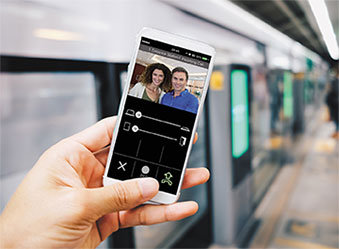
As smartphones and digital applications have become a staple in everyday life, mobile applications have emerged as a valuable tool in security. Given that some mobile applications can remain connected to a network 24/7, security personnel at commercial buildings will benefit as this function offers several benefits, such as staying connected to the central security system while on patrol, remote monitoring, receiving urgent notifications, approving visitors using a video intercom system, etc.
Most importantly, mobile applications provide direct communication between users and security officers. When security personnel are not in the control room, calls can be immediately forwarded and answered to their smartphones via mobile applications. These added functionalities ultimately enhance security throughout commercial buildings, benefiting parties in both office spaces and retail areas.
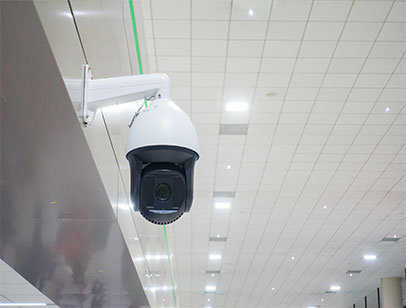
Security cameras are essential to any commercial building's security plan, as they provide increased visibility for security personnel and ultimately help deter crime. Compared to previously used analog cameras, IP cameras are now more commonly deployed due to their high-resolution image quality. In addition, IP cameras and their installation are not limited to local outlets as they are powered over Ethernet (PoE). These cameras can also be wireless, which is incredibly convenient in large parking lots where cable installation is expensive due to the vast coverage area.
Network video recorders (NVRs) and software analytics should also be utilized with IP cameras, as these solutions provide added benefits, such as capturing real-time events and video evidence in the event of a crime or even creating alarms for user-defined events like potentially harmful unattended packages. Commercial buildings should install these cameras at entry points, perimeters, and high-foot traffic areas like hallways and stairwells. Outdoor surveillance at parking lots, walking trails, and other remote areas is also crucial. The implementation of these solutions generally remains the same for offices and commercial spaces.
Considering that an unspecified number of people come and go at commercial facilities, security measures like access control systems may only sometimes be effective. Instead, video monitoring and CCTVs (closed-circuit televisions) should be the primary security measure for deterrence. This is particularly important in areas that render access control systems ineffective, such as retail areas where customers are not usually required to sign in.
Emergency and Assistance - On a daily basis, several emergencies may arise in commercial buildings- be it from office workers, vendors, or guests. Security cameras deliver clear, precise visibility in remote areas essential to first responders when responding to emergencies and providing prompt assistance. Infrared cameras may also be utilized in dimly lit locations.
Emergency stations are also critical in providing urgent assistance, benefiting both security personnel and users. These stations are usually towers or wall-mounted, with features like audio-video door stations, built-in cameras, and master stations to facilitate two-way communication. To ensure visibility, these emergency stations are marked with a bright revolving light. A non-emergency call button is also available, making it suitable for day-to-day user inquiries relevant to commercial buildings.
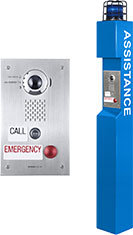
These consist of sensors, motion detectors, and audible alarms that are triggered depending on the parameter set by building administrators, which can be customized to fit the needs of an office or retail area. These sensors are specialized, each serving its purpose, and can be placed in different parts of commercial buildings.
As a communication tool, a video intercom system is indispensable across a commercial building's security plan for visitor management or emergency and assistance. Depending on the system used, a video intercom system can utilize master stations, guard stations, tenant stations, or mobile applications. To properly implement a video intercom system for office and commercial use, these stations should be installed at entry points, reception areas, and security control centers.
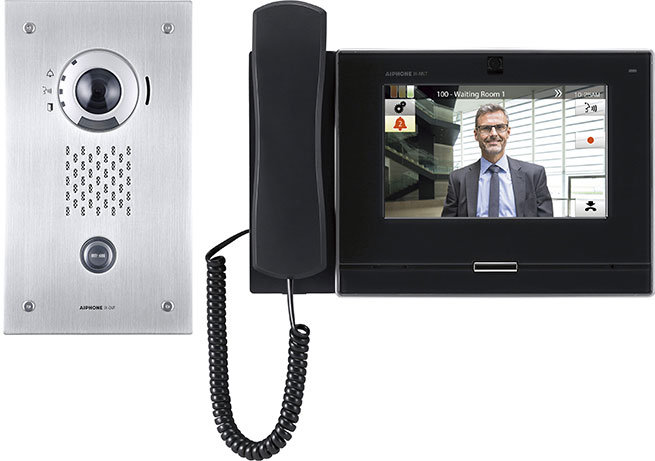
A video intercom system is critical for visitor screening and managing access control in commercial buildings. Visitors can initiate a two-way conversation through door stations, which are then connected to a master station or guard station operated by building security. Mobile applications can also be used by security personnel to view incoming calls, grant building access, and monitor surroundings at entry points with video intercom stations.
For both offices and retail spaces, additional uses and security benefits of an IP video intercom system include using built-in high-definition cameras to verify identification cards, easy handling of vendors' access requests at loading docks and service entrances, granting entry to employees with missing or faulty credentials, and other similar uses.
Commercial buildings often use various security products from different providers, so ensuring compatibility between these solutions is essential. The selected peripherals should work together seamlessly, and commercial buildings should remember this. When integrating solutions, the following considerations should be the main focal points:
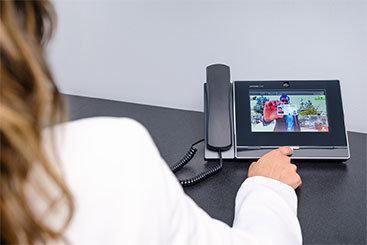
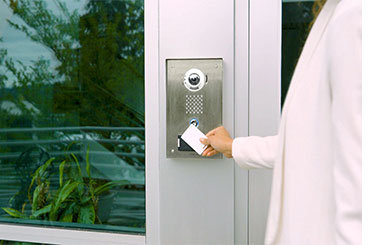
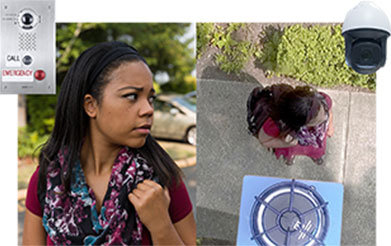
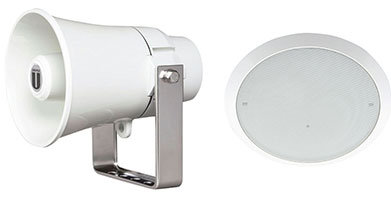
This is also an essential part of commercial buildings' communications system, primarily for one-way, in-house broadcasting of important messages. This is especially relevant for specific security scenarios where public service announcements are necessary, like during potential disasters or safety incidents.
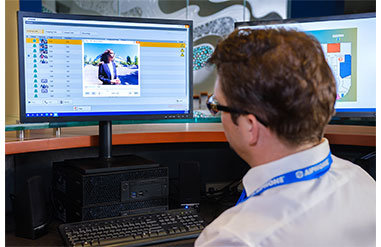
These solutions reflect that several security measures can be readily implemented across commercial buildings for offices and commercial areas, each serving a specific purpose within a multi-layered plan. Implementing these security solutions together can enhance building security and cater to the diverse needs of users, be it for visitors in commercial areas, employees in office spaces, and many more.
To properly develop a security plan utilizing these solutions, it is crucial first to coordinate and engage with key stakeholders, such as building administrators, department heads, and staff members. Guided by this, a specific, tailored security plan can be created for users in offices and retail areas, where the most effective policies, procedures, and equipment can be easily identified.
Founded in 1948, Aiphone is an industry pioneer providing communication systems solutions to clients across the globe. With a strong presence in Asia (including Hong Kong, Indonesia), Australia, North America, and Europe (including the United Kingdom), Aiphone serves businesses across several sectors. Such experience has manifested in the versatile range of intercom solutions that seamlessly integrate into various settings, such as apartment complexes, detached housing, and office buildings. Possessing over 70 years of industry expertise and over 30 standard communication system offerings, Aiphone services guarantee its customers' safety, security, and comfort.
Click here to learn more about how Aiphone's wide range of communication system solutions can fulfill your business' various security needs. For inquiries, please contact our inquiry desk, which you can access here.